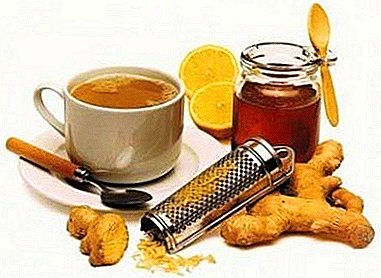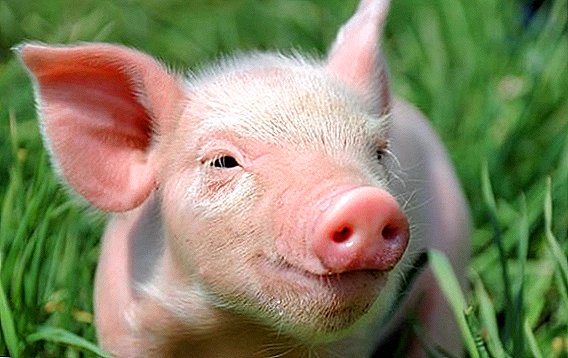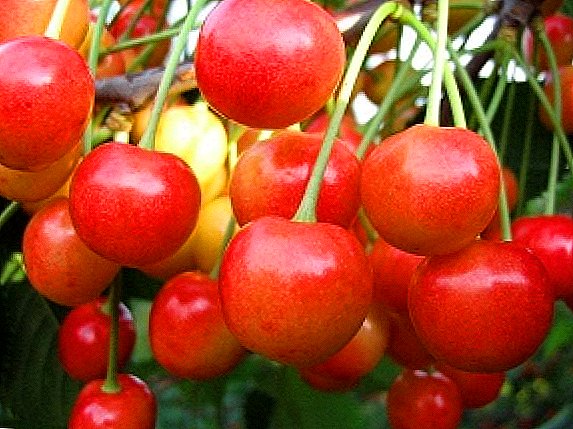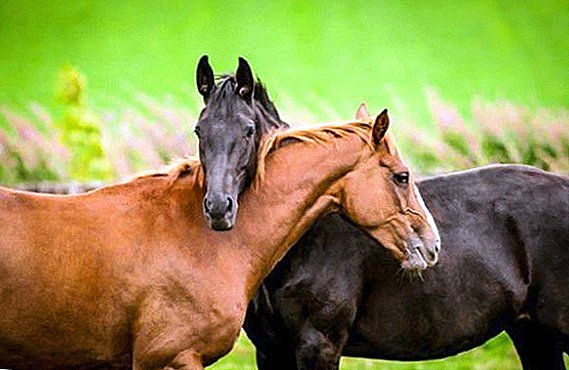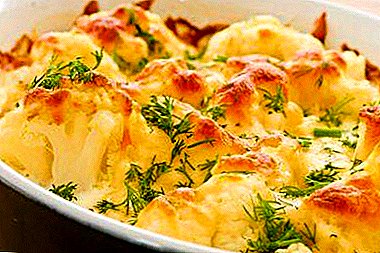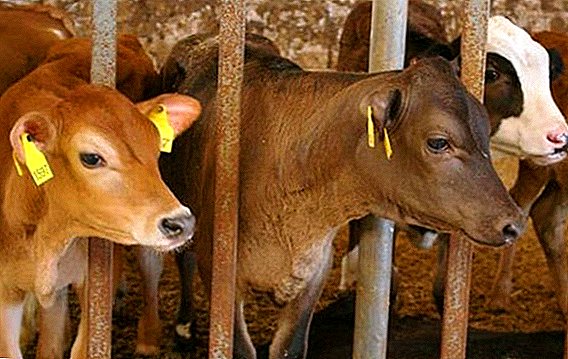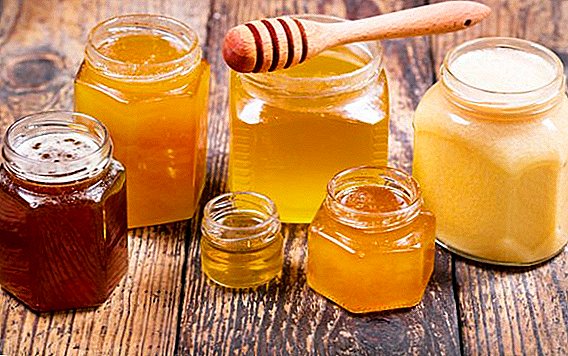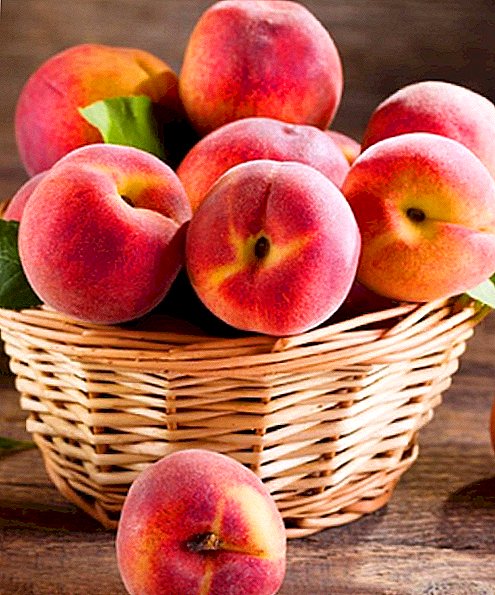 Nectarine - This is a very popular peach variety. Fragrant fruits are common both in our country and abroad. This juicy fruit belongs to the category of skoroplodny, short-lived plants, has an original taste and has excellent commercial quality. Many people believe that nectarine is a peach crossed with a plum: most likely, the smooth skin of the fruit is misleading, but this is only the classic mutation of an ordinary peach.
Nectarine - This is a very popular peach variety. Fragrant fruits are common both in our country and abroad. This juicy fruit belongs to the category of skoroplodny, short-lived plants, has an original taste and has excellent commercial quality. Many people believe that nectarine is a peach crossed with a plum: most likely, the smooth skin of the fruit is misleading, but this is only the classic mutation of an ordinary peach.
Did you know? The name of the peach is derived from the word "nectar" due to the increased sugar content in the fruit.Nectarines are grown in many varieties, and nowadays there are even hybrid varieties that are winter-hardy and perfectly suited to our region. The most popular are species that are well transported and stored. Let's get acquainted with nectarine and turn to the description of its varieties.
"Stark Red Gold"
"Stark Red Gold" - This is a variety that was bred in the USA due to free pollination of the Sangrend plant.  A medium-sized single-crown tree has symmetric round fruits (weighing 180–200 g) ripening in mid-August. The dense pulp of fruit, well separated from the stone, is different. excellent taste.
A medium-sized single-crown tree has symmetric round fruits (weighing 180–200 g) ripening in mid-August. The dense pulp of fruit, well separated from the stone, is different. excellent taste.
The appearance of nectarines has a bright red color, and the flesh has a rich yellow color. Winter hardiness of this high-grade variety is above average.
"Stark Red Gold" It is recommended for cultivation both in private plots and in industrial gardening.
"Nectarine 4"
"Nectarine 4" ("Nectared-4") is an American variety that was bred in New Jersey in 1962.  The tree has good fruitfulness of medium and high growth. Maturation occurs by early August. The variety has resistance to winter cold and fungi. The fleshy flesh of yellow-orange tones gives a stunning dessert taste.
The tree has good fruitfulness of medium and high growth. Maturation occurs by early August. The variety has resistance to winter cold and fungi. The fleshy flesh of yellow-orange tones gives a stunning dessert taste.
The rounded ovals of dark red fruits are large enough (weight 140-160 g). The small bone is easily separated from the pulp.
"Fantasy"
The history of the nectarine variety "Fantasy" It begins at the University of California, where the fruit originated during the crossing of the related Red King and Mountain King varieties. Tree of high strength growth.
Blossoming earlier and very plentiful. Fruits of round shape can have medium and very large sizes. Nectarines of this variety have a smooth golden-yellow skin, decorated with rosy divorces of dark carmine.  Appetizing yellowish flesh is successfully combined with a reddish tinge at the skin and around the stone. The weight of the marketable fruit fluctuates between from 120 to 180 g. The fruit is extremely tasty due to the optimal balance of acid and sugar.
Appetizing yellowish flesh is successfully combined with a reddish tinge at the skin and around the stone. The weight of the marketable fruit fluctuates between from 120 to 180 g. The fruit is extremely tasty due to the optimal balance of acid and sugar.
"Fantasy" - variety, endowed with high winter hardiness and resistance to pests and diseases. Juicy fruits are beautifully eaten fresh, but also popular is the use of candied fruit and processed juice. Well kept and frozen.
"Ruby 7"
One of the most popular varieties of nectarine is "Ruby 7". It is considered to be one of the most productive varieties with excellent fruit qualities.
Fruits ripen from the second half of August. A tree bearing fruit every two to three years has a medium size and a spreading crown.  In large (150-180 g) dark red fruits have a round shape. The interior under the skin is generally yellow, but reddening under the surface and near the stone, very juicy and melting, with high taste characteristics.
In large (150-180 g) dark red fruits have a round shape. The interior under the skin is generally yellow, but reddening under the surface and near the stone, very juicy and melting, with high taste characteristics.
From the bone is separated without difficulty. Features grade - High winter hardiness, as well as medium disease resistance.
Try to grow in your garden these types of fruit trees: apple varieties "Sun", zizifus, apricot varieties "Prince March", plum varieties "Eurasia", cherry plum, pear varieties Kokinskaya, felt cherry.
"Scythian"
Nectarine "Scythian" is one of the largest varieties. It has sweet yellow fruits with a bright red blush on almost the entire surface.
The strong-growing tree has a slightly pyramidal crown, its height reaches from 5 to 7 meters. It grows very quickly at a young age, and in fruitful moderation, it blooms in mid or late April.
Large and medium size (120-180 g) fruits endowed with a round spherical shape. Very fragrant, dense and juicy pulp easily separated from the stone. Harvest should be in mid-August.  Young shoots can be damaged by frost if they are located in low places on overmoistened soils. The advantages of the "Skiff" variety are abundant yield, fruits of pleasant taste and resistance of flower buds to frost.
Young shoots can be damaged by frost if they are located in low places on overmoistened soils. The advantages of the "Skiff" variety are abundant yield, fruits of pleasant taste and resistance of flower buds to frost.
These fruits are enjoyed both in a freshly picked form, and as a part of the jam, as well as they are usually baked, canned and frozen.
Did you know? In folk medicine used healing oils from nectarine seed.
"Crimean"
Nectarines "Crimean" have universal, drought-resistant properties, high heat resistance. At medium height is rounded, the usual density of the crown.
The tree grows fast enough. Fruits are one-dimensional, round and rather large (160 g). Smooth and brilliant yellow skin is endowed with a dark blush and lacks villi, it is difficult enough to remove.  Around the stone, immersed in the yellow flesh, stands a beautiful crimson edging. Fruit can be used to prepare compotes and juices, as well as used for making jam and candied fruit.
Around the stone, immersed in the yellow flesh, stands a beautiful crimson edging. Fruit can be used to prepare compotes and juices, as well as used for making jam and candied fruit.
Variety "Crimean" fruits after planting in the second or third season, his winter hardiness is above average. Transported very easily.
Important! Nectarines cleanse the body, enrich it with vitamins, improve digestion, metabolism and prevent the development of cancer cells. But if you suffer from allergies, obesity or diabetes, you should refrain from eating this dessert fruit.
"Lola"
The Uzbek sugar has a higher sugar content, unlike foreign varieties. "Lola".
Nectarine has an amazing, sharp-sweet taste and excellent aroma. The fruits are creamy greenish, but most of the skin is dark red. Their weight is only 80-100 g.  The pulp is fibrous, dense and white. Trees of medium height, crown wide oval and slightly sprawling. The main advantages of "Lola" - soon ripening and increased resistance to low temperatures.
The pulp is fibrous, dense and white. Trees of medium height, crown wide oval and slightly sprawling. The main advantages of "Lola" - soon ripening and increased resistance to low temperatures.
A few spoils a good picture of susceptibility to attacks of powdery mildew and fruit rot, but this fate, alas, did not escape all other representatives of this culture.
You can fertilize the soil for your plants with wood ash, mineral fertilizers, potassium humate, superphosphate, peat, and biohumus.
"Favorite"
Ukrainian summer variety "Favorite" will delight you with an exquisite sweetish taste with spicy sourness.
Such trees are grown in the Kiev region, their growth is of medium height, and the crown is uneven and sprawling. They bloom in mid or late April, have excellent fruitfulness (approximately 0.5-0.7 kg per tree) in two to four years.  In addition to excellent taste and optimal weight (150-180 g), the fruits are endowed with a very appetizing appearance: yellow-cream color with a light pink blush. Stone is quite easily removed from the pulp.
In addition to excellent taste and optimal weight (150-180 g), the fruits are endowed with a very appetizing appearance: yellow-cream color with a light pink blush. Stone is quite easily removed from the pulp.
The fruit has tangible advantages over other varieties - almost not exposed fungal diseases and remarkably tolerates winter frost.
Important! In the southern regions, seedlings are best grown in the fall, and in the north - in the spring.
"Stark Sanglo"
Bred by American breeder A. Anderson variety "Stark Sanglo" It is very popular among farmers and other manufacturers.
The tree is medium thick, with a broad obscure crown, has an average density. The fruits are very attractive, rounded and slightly asymmetric. Yellowish skin with rich burgundy blush lacks villus.  The bone can be easily separated from the flesh, which is nectarine fleshy, fibrous, sweetish with a little noticeable sourness, very fragrant and containing a high percentage of sugar.
The bone can be easily separated from the flesh, which is nectarine fleshy, fibrous, sweetish with a little noticeable sourness, very fragrant and containing a high percentage of sugar.
They eat these fruits fresh and frozen, and they are also great for making jam.
"Stark Sanglo" - high quality variety, valued for large fruits and good yield. It differs not only in winter hardiness, but also in resistance to spring frosts and to common disease - powdery mildew.
Crimson Gold
High stable yield, rapidity and increased frost-resistant properties stand out among the Crimean nectarine varieties Crimson Gold.  Its exceptional taste will appeal even to the most capricious consumer. Nectarine trees are of medium size, and their fruits are quite large, weighing 115-130 g. Develop well on stony and calcareous soil.
Its exceptional taste will appeal even to the most capricious consumer. Nectarine trees are of medium size, and their fruits are quite large, weighing 115-130 g. Develop well on stony and calcareous soil.
Trees begin to bear fruit later than others - in the 4-5th year. The yellow skin has a strong crimson blush, and the melting and juicy flesh has a yellow-orange hue. This variety is very valuable in Ukraine, where it is considered the most common.
Did you know? Farmers say that nectarine can sometimes appear on a peach tree, and vice versa.Nectarine in our area - relatively rare culture. Domestic gardeners are not very interested in "hollow fruit" peach.
There is nothing surprising in this, because there appeared “bald” varieties no more than half a century ago, but more and more often sellers spoil buyers the best flavors of aromatic nectarines: they appear on the shelves and quickly disappear, thereby increasing the likelihood that this crop will settle tightly in fruit gardens.



